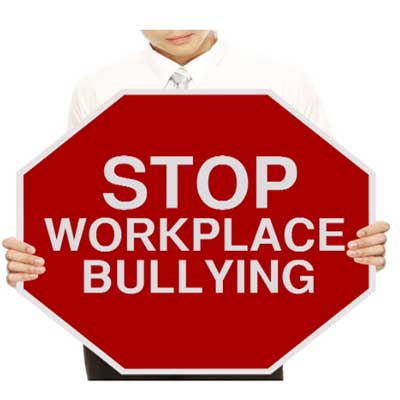How to stop bullying in the workplace? | Aparna Sharma | Senior HR Professional & Certified Corporate Director I Editor’s Collection
Workplace Bullying
 For many people, including myself, the word ‘bullying’ may spark unpleasant memories from the school playground. When I left school I imagined a life free of bullying. I thought to myself that I have experienced bullying as a kid and teen and I have learned ways to cope and so surely I would not be bullied in my adult life. I was wrong. How can anyone bully an adult? The sad reality is, people can be bullied at any age and in any situation. The tactics may change but the behaviour is unfortunately not that different. Adults are bullied at their workplace on a regular basis.
For many people, including myself, the word ‘bullying’ may spark unpleasant memories from the school playground. When I left school I imagined a life free of bullying. I thought to myself that I have experienced bullying as a kid and teen and I have learned ways to cope and so surely I would not be bullied in my adult life. I was wrong. How can anyone bully an adult? The sad reality is, people can be bullied at any age and in any situation. The tactics may change but the behaviour is unfortunately not that different. Adults are bullied at their workplace on a regular basis.
What is Workplace Bullying?
It usually involves acts or verbal comments that could mentally hurt or isolate a person in the workplace. Bullying can be between two individuals or it may involve groups of people. It might be obvious or it might be more subtle. It can include any kind of abuse or violence whether it be physical or verbal. It can occur in written communications, by phone, and/or email not just face-to-face actions.
Examples of bullying
Bullying includes abuse, physical or verbal violence, humiliation and undermining someone’s confidence. You are probably being bullied if, for example, you are…
- – Being constantly picked on
- – Being shouted at or the target of spontaneous rage
- – Being humiliated in front of colleagues
- – Your views and opinions being ignored
- – Blamed for problems caused by others
- – Being set unreasonable/impossible deadlines or unmanageable workloads
- – Regularly threatened with losing your job
- – Unfairly passed over for promotion or denied training opportunities
Solutions to workplace bullying
- EMOTIONAL – try your best not to be emotional.People who bully take pleasure in emotionally manipulating their victims. I want you to think about how you currently REACT to difficult people and those challenging situations. Now think about how you would like to feel, think and respond to future situations. Responding is different to reacting. When you respond, you have PREPARED in advance the OUTCOME in your mind. Begin with the end in mind. What is your end in mind? What outcomes would you like to see?STAND UP – for yourself – if you are being bullied, then you should tell the person who is bullying you that their behaviour is unreasonable and inappropriate and you want it to stop. Of course, this can be very difficult if the perpetrator is your boss. It can be hard to stand up to workplace bullying because the person bullying you can make you feel and believe that “you’re overreacting”, “you’re just oversensitive” and then you’re actually AFRAID of standing up for yourself. It’s all a dominance game. CONFIDENCE – don’t blame yourself. Acknowledge that this is not about you; it’s about the person who is bullying.
- EVALUATE– the situation objectively to see if the situation is bullying.
- RIGHTS– it is important to realise every employer has a responsibility to provide a safe work environment. BE AWARE – of your workplace bullying POLICY – from this policy you should familiarise yourself with the REPORTING PROCEDURE. Follow your workplace procedure for reporting bullying.
- RESEARCH– learn everything you can about bullying, your company’s policies on inappropriate behavior and legislation related to health and safety at work. The more you know, the better your chances of successfully dealing with the situation.
- DOCUMENT– your situation thoroughly – write everything down – who said what – dates and times – list any witnesses – what actions were taken – how you responded. It can be a time consuming writing down all the stuff but it is a necessity. What is important is to be SPECIFIC in your recording rather than GENERALISING.
- TALK– with someone you trust. Don’t ignore what has happened or is happening.
- SUPPORT – LEGAL– talk to your legal representative, if necessary. COUNSELLING – seek professional counselling or advice, if necessary. DOCTOR – talk to your doctor, if necessary.
- HUMAN RESOURCES– Get supervisors and HR involved.
- STAY HEALTHY – maintain a healthy and balanced lifestyle outside of work to help you cope with the madness at work. Work out, get a good night’s sleep and eat a healthy diet.
MOVING ON – if the situation does get resolved, you need to move on emotionally. If the situation cannot be resolved, then consider your options for leaving. CHANGE – don’t expect to change the bully. Real behavior change is difficult and it takes time. You have no control over the person’s willingness to accept that they have a problem and to work on it. You can do your best to manage the situation, but it’s really the company’s responsibility to be observant and responsive to the needs of their workers and the general work environment. In the worst-case scenario you may need to leave your job or be prepared for a long hard fight with the person bullying you and your employer.


